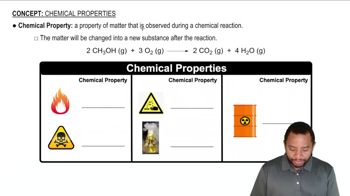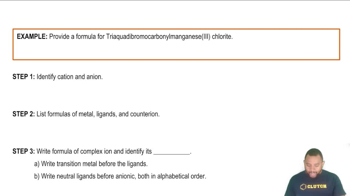Iron corrodes to produce rust, Fe2O3, but other corrosion products that can form are Fe(O)(OH), iron oxyhydroxide, and magnetite, Fe3O4. (a) What is the oxidation number of Fe in iron oxyhydroxide, assuming oxygen's oxidation number is -2? (b) The oxidation number for Fe in magnetite was controversial for a long time. If we assume that oxygen’s oxidation number is - 2, and Fe has a unique oxidation number, what is the oxidation number for Fe in magnetite? (O)(OH), iron oxyhydroxide, and magnetite, Fe3O4. (c) It turns out that there are two different kinds of Fe in magnetite that have different oxidation numbers. Suggest what these oxidation numbers are and what their relative stoichiometry must be, assuming oxygen’s oxidation number is -2.
Ch.20 - Electrochemistry
Chapter 20, Problem 88c,d
Copper corrodes to cuprous oxide, Cu2O, or cupric oxide, CuO, depending on environmental conditions. (c) Copper peroxide is another oxidation product of elemental copper. Suggest a formula for copper peroxide based on its name. (d) Copper(III) oxide is another unusual oxidation product of elemental copper. Suggest a chemical formula for copper(III) oxide.
 Verified step by step guidance
Verified step by step guidance1
To determine the formula for copper peroxide, we need to understand the naming convention. 'Peroxide' indicates the presence of the peroxide ion, which is \( \text{O}_2^{2-} \). Copper typically forms \( \text{Cu}^{+} \) or \( \text{Cu}^{2+} \) ions, but in this case, we assume it forms \( \text{Cu}^{2+} \) to balance the charge with the peroxide ion.
The formula for copper peroxide can be deduced by balancing the charges between copper and the peroxide ion. Since the peroxide ion has a charge of \( 2- \) and copper is \( \text{Cu}^{2+} \), the formula is \( \text{CuO}_2 \).
For copper(III) oxide, we need to consider the oxidation state of copper. Copper(III) indicates that copper is in the +3 oxidation state, represented as \( \text{Cu}^{3+} \).
To balance the charges in copper(III) oxide, we need to pair \( \text{Cu}^{3+} \) with oxygen, which typically forms \( \text{O}^{2-} \) ions. To balance the charges, two copper ions (total charge of +6) would pair with three oxide ions (total charge of -6).
Thus, the chemical formula for copper(III) oxide is \( \text{Cu}_2\text{O}_3 \).

Verified video answer for a similar problem:
This video solution was recommended by our tutors as helpful for the problem above.
Video duration:
1mWas this helpful?
Key Concepts
Here are the essential concepts you must grasp in order to answer the question correctly.
Oxidation States
Oxidation states indicate the degree of oxidation of an atom in a compound. For copper, common oxidation states include +1 (cuprous) and +2 (cupric), with +3 being less common. Understanding oxidation states is crucial for determining the correct chemical formulas for compounds like copper oxide and copper peroxide.
Recommended video:
Guided course

Oxidation Numbers
Chemical Nomenclature
Chemical nomenclature is the system of naming chemical compounds based on their composition and structure. For example, 'copper(III) oxide' indicates that copper has an oxidation state of +3 in the compound. Familiarity with nomenclature rules helps in deducing the correct formulas for compounds from their names.
Recommended video:
Guided course

Chemical Properties
Compound Formulas
The formula of a compound reflects the types and numbers of atoms present. For copper peroxide, the name suggests a compound containing copper and oxygen, likely with copper in a +1 oxidation state, leading to the formula CuO2. Similarly, copper(III) oxide would be represented as Cu2O3, indicating the presence of copper in a +3 state.
Recommended video:
Guided course

Writing Formulas of Coordination Compounds Example
Related Practice
Textbook Question
Textbook Question
Copper corrodes to cuprous oxide, Cu2O, or cupric oxide, CuO, depending on environmental conditions. (a) What is the oxidation state of copper in cuprous oxide?
Textbook Question
(c) What process occurs at the anode in the electrolysis of molten NaCl?
Textbook Question
(d) Why is sodium metal not obtained when an aqueous solution of NaCl undergoes electrolysis?
